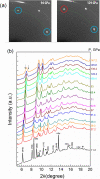Pressure-induced high-spin/low-spin disproportionated state in the Mott insulator FeBO3
- PMID: 35689001
- PMCID: PMC9187741
- DOI: 10.1038/s41598-022-13507-4
Pressure-induced high-spin/low-spin disproportionated state in the Mott insulator FeBO3
Abstract
The pressure-induced Mott insulator-to-metal transitions are often accompanied by a collapse of magnetic interactions associated with delocalization of 3d electrons and high-spin to low-spin (HS-LS) state transition. Here, we address a long-standing controversy regarding the high-pressure behavior of an archetypal Mott insulator FeBO3 and show the insufficiency of a standard theoretical approach assuming a conventional HS-LS transition for the description of the electronic properties of the Mott insulators at high pressures. Using high-resolution x-ray diffraction measurements supplemented by Mössbauer spectroscopy up to pressures ~ 150 GPa, we document an unusual electronic state characterized by a "mixed" HS/LS state with a stable abundance ratio realized in the [Formula: see text] crystal structure with a single Fe site within a wide pressure range of ~ 50-106 GPa. Our results imply an unconventional cooperative (and probably dynamical) nature of the ordering of the HS/LS Fe sites randomly distributed over the lattice, resulting in frustration of magnetic moments.
© 2022. The Author(s).
Conflict of interest statement
The authors declare no competing interests.
Figures





References
-
- Mott NF. Metal-Insulator Transitions. Taylor & Francis; 1990.
-
- Imada M, Fujimori A, Tokura Y. Metal-insulator transitions. Rev. Mod. Phys. 1998;70:1039–1263. doi: 10.1103/RevModPhys.70.1039. - DOI
-
- de’Medici, L., Gianluca, G., Capone, M. Selective Mott Physics as a Key to Iron Superconductors. Phys. Rev. Lett. 2014;112:7001–7005. - PubMed
-
- Mott, N. F. In The metallic and nonmetallic states of matter (Edwards and Rao editors, chapter 1, 1985).
Grants and funding
LinkOut - more resources
Full Text Sources

